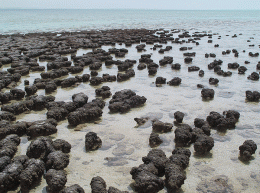December 9, 2008 feature
Why Life Originated (And Why it Continues)

(PhysOrg.com) -- Today, scientists understand pretty well how life evolves, by mechanisms based on Darwin’s theory of natural selection for survival of the fittest. However, Darwin’s 1859 classic, On the Origin of Species, somewhat ironically doesn’t answer that very question – how species actually originated. And to this day, how that first tiny pool of chemicals twitched to life remains a puzzle.
In a recent study called “Why did life emerge?”, two scientists, son and father Arto Annila of the University of Helsinki and Erkki Annila of the Finnish Forest Research Institute, offer some insight into the general driving force of life’s origins in terms of thermodynamics. As they explain, all organisms are composed of molecules that assemble together via numerous chemical reactions. Just as heat flows from hot to cold, these molecules obey the universal tendency to diminish energy differences, so that the most likely chemical reactions are those in which energy flows “downhill” toward a stationary state, or chemical equilibrium.
Although the researchers don’t speculate on the specific chemical reactions that created life, they explain that the molecules involved most likely underwent a series of more and more complex reactions to minimize mutual energy differences between matter on Earth and with respect to high-energy radiation from Sun. The process eventually advanced so far that it cumulated into such sophisticated functional structures that could be called living.
“The most important idea in our study is that there is no distinction between animate and inanimate,” Arto Annila told PhysOrg.com. “Processes of life are, in their principles, no different from any other natural processes.”
In their study, which is published in the International Journal of Astrobiology, the researchers considered a primordial pool that contained some basic compounds. By reacting with one another and coupling with an external energy source such as the Sun, the compounds formed a chemical system. The compounds continually engaged in chemical reactions, thriving the most when capturing and distributing more and more of the Sun’s energy in the quest for a steady state. The evolutionary process was and still is non-deterministic, even chaotic, since the energy flows create energy differences that in turn affect the flows.
Due to random variations stemming from the chemical reactions, some novel compounds may have emerged in the primordial system. Some of these compounds (such as those involving carbon) might have been exceptionally good at creating energy flow, enabling the system to diminish energy differences very efficiently and reach a higher level of entropy. Compounds with these advantages would have gained ground during this period of primitive chemical evolution. But the scientists emphasize that identifying which exact compounds were key players during this period would be very difficult to determine.
“Today we may have only very little evidence left from the courses in the very distant past to deduce which chemical species went extinct, while others, more viable in energy transduction, emerged,” Arto Annila explained. In other words, this study focuses on why life emerged, not how.
What is more relevant, the scientists note, is the fact that the physical tendency to diminish energy differences makes no distinction between systems that are inanimate or animate. As the researchers explain, the order and complexity that characterize modern biological systems have no value in and of themselves, but structure and hierarchical organization emerged and developed because they provided paths for increasing energy flows.
The scientists give several examples of mechanisms associated with life that increase entropy. For instance, when systems (e.g. molecules) become entities of larger systems (e.g. cells) that participate in larger ranges of interactions to consume more free energy, entropy increases. Genetic code might have served as another primordial mechanism, acting as a catalyst that could increase energy flow toward greater entropy. Today, complex organisms have cellular metabolism, which is another mechanism that increases entropy, as it disperses energy throughout the organism and into the environment. The food chain in an ecosystem is another example of a mechanism for transferring energy on a larger scale.
In this sense, life is a very natural thing, which emerged simply to satisfy basic physical laws. Our “purpose,” so to speak, is to redistribute energy on the Earth, which is in between a huge potential energy difference caused by the hot Sun and cold space. Organisms evolve via natural selection, but at the most basic level, natural selection is driven by the same thermodynamic principle: increasing entropy and decreasing energy differences. The natural processes from which life emerged, then, are the same processes that keep life going – and they operate on all timescales.
“According to thermodynamics, there was no striking moment or no single specific locus for life to originate, but the natural process has been advancing by a long sequence of steps via numerous mechanisms so far reaching a specific meaning – life,” the researchers explained.
And because thermodynamics recognizes no specific moment, particular place, compound or reaction that would distinguish animate from inanimate, a search for ‘the birth of life’ seems like an ill-posed project, Arto Annila explained.
“Indeed, the quest for the origin of life seems a futile endeavor because life in its entirety is a natural process that has, according to the second law of thermodynamics, no definite beginning,” he said. “To ask how life started would be the same as to ask when and where did the first wind blow that quivered the surface of a warm pond.”
More information: Annila, Arto and Annila, Erkki. “Why did life emerge?” International Journal of Astrobiology 7 (3 & 4 ): 293-300 (2008).
Copyright 2008 PhysOrg.com.
All rights reserved. This material may not be published, broadcast, rewritten or redistributed in whole or part without the express written permission of PhysOrg.com.

















